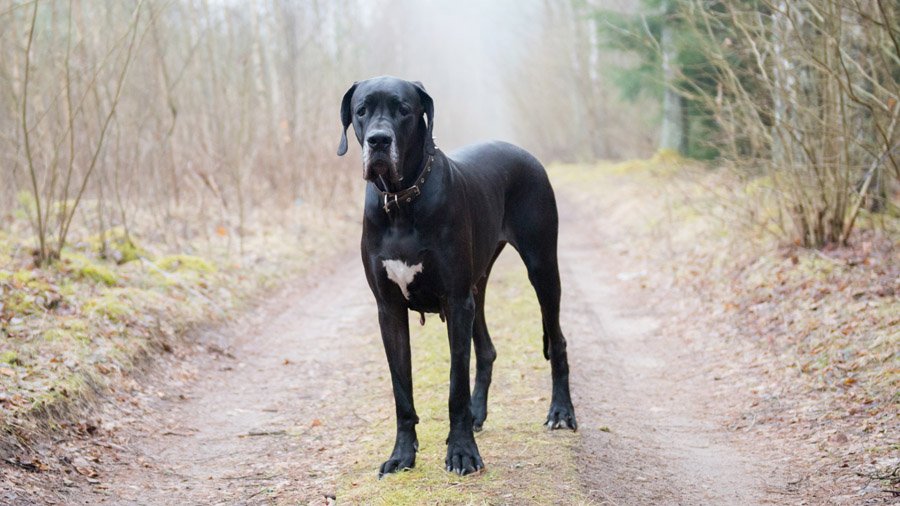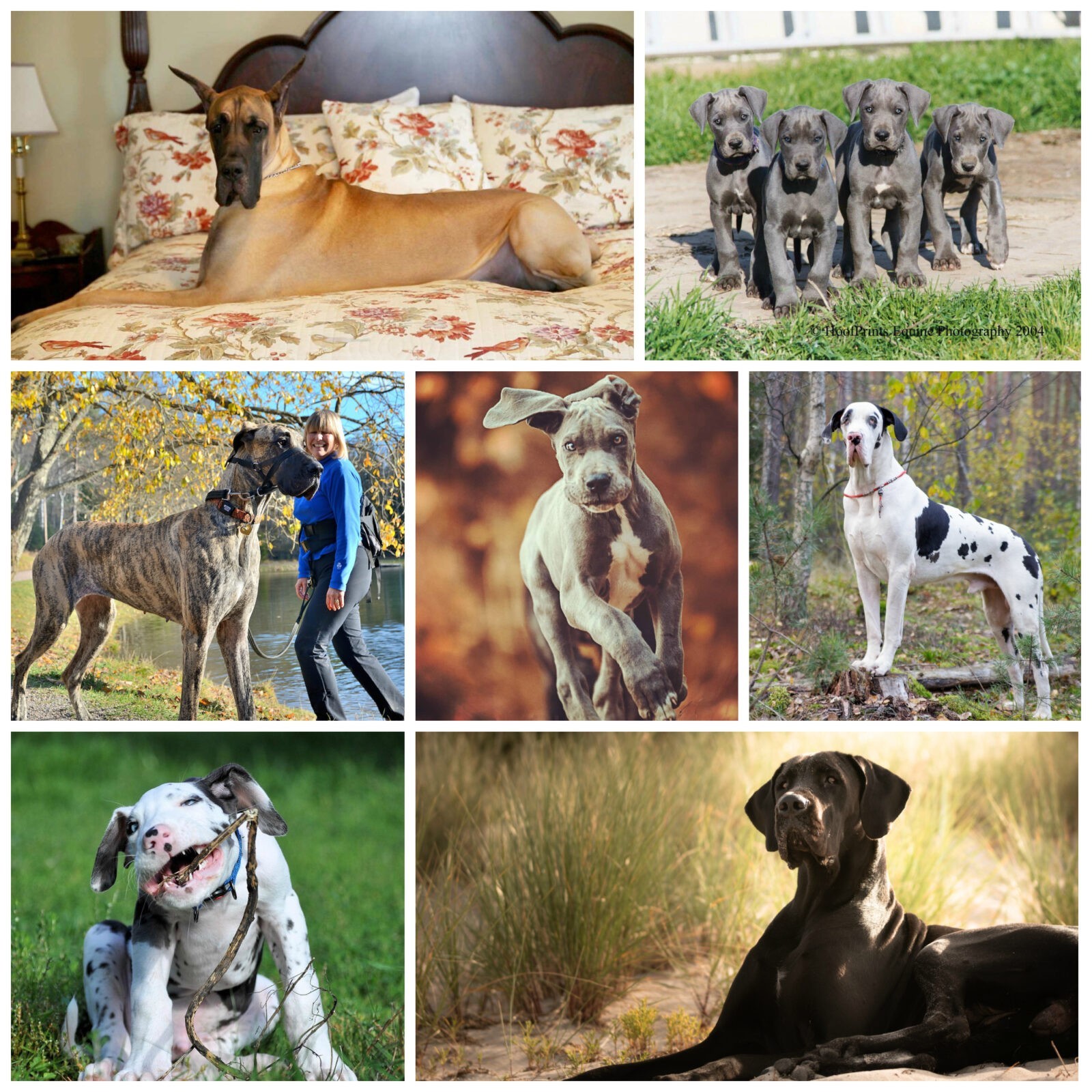
Краткое описание породы
Немецких догов изначально разводили для охоты на дикого кабана. С этой задачей собака справлялась не очень хорошо. Поэтому селекционеры прекратили свои попытки в этом направлении. Сейчас немецкий дог — это животное с теплой душой, которое хорошо ладит как с людьми, так и с другими животными.
Хотя доги не отличаются злобой и агрессией, все же внушительные размеры немецкого дога способны спугнуть любого грабителя или злоумышленника, что часто играет на руку владельцам таких питомцев.
Немецкий дог произошел от мастифоподобных собак, но, в отличие от других потомков этих собак, немецкий дог более изящен. Собака имеет атлетическое, мускулистое телосложение. Отличается массивной головой и несколько удлиненным туловищем. Немецкий дог является владельцем удлиненной, изящной шеи, которая придает собаке особого шарма. Уши дога часто купируют, но это не обязательно. Все зависит от предпочтений хозяина.
Внушительные размеры собаки часто доставляют неприятности хозяину и его семье. Животное может ненароком сталкивать предметы декора или интерьера. Поэтому немецкого дога лучше содержать в просторных домах или квартирах.
Несмотря на свои размеры, немецкий дог – доброе и ласковое животное. Он любит нежность, ласку, обожает играться с детьми. При этом всегда готов проявить смелость, особенно если дело касается защиты семьи.
Хотя немецкий дог и отличается мягкостью характера, все же владельцу этой собаки необходимо уделить должное внимание вопросам воспитания питомца. Лучше всего прибегнуть к помощи специалиста.
Собаки этой породы всегда жаждут желанием угодить хозяину, они всячески пытаются понравиться ему и членам семьи. Немецкие доги испытывают огромное счастье, когда их гладят, ласкают, они не прочь понежиться на диванчике или в кресле хозяина.
Примечательно, что, несмотря на свои размеры, немецкий дог не способен съесть много еды. Кроме того, ему не нужен большой двор. Собака будет чувствовать себя комфортно и в небольшом дворике. Главное — предупредить возможность повреждения предметов интерьера и декора в доме.
Благодаря изяществу и покладистому характеру, немецкий дог пользуется чрезвычайной популярностью. На сегодняшний день порода по своей популярности занимает 24-е место среди зарегистрированных Американским клубом собаководства.
Печальный момент заключается в том, что в связи с большим размером, немецкий дог имеет короткую продолжительность жизни: до 8 лет.
Основная информация
| Название породы: | Немецкий дог |
| Страна происхождения: | Германия |
| Время зарождения породы: | 3000 лет до нашей эры |
| Тип: | молоссы |
| Вес: | 50 – 87 кг |
| Рост (высота в холке): | 72 – 80 см |
| Продолжительность жизни: | 7 – 8 лет |
|
Классификация МКФ:
|
Группа 2, Секция 2, Номер 235 |
| Цена щенков: | 450 – 1550 $ |
| Самые популярные клички: | список кличек для немецкого дога |
Оценка характеристик породы
| Адаптивность
(определение, означающее, насколько легко собака может приспосабливаться к изменениям в жизни) |
🐶🐶🐶 |
| Уровень линьки
(Уровень и частота выпадения волос у животного) |
🐶🐶🐶 |
| Уровень нежности
(Уровень и количество нежности и ласки, которую собака отдает взамен на внимание к себе) |
🐶🐶🐶 |
| Потребности в упражнениях
(Уровень дневной активности собаки) |
🐶🐶 |
| Социальная потребность
(Необходимое количество контактов собаки с другими животными, а также людьми) |
🐶🐶🐶🐶 |
| Квартирное содержание
(Фактор, определяющий уровень шума и иных неудобств, которые собака может доставлять хозяевам в соотношении размера квартиры к размеру собаки) |
🐶🐶🐶🐶🐶 |
| Груминг
(Количество купаний, расчесываний, а также необходимое количество сеансов профессионального груминга, необходимого собаке) |
🐶 |
| Дружелюбность в незнакомой среде
(Особенности поведения собаки в обществе с незнакомыми людьми или в незнакомой обстановке) |
🐶🐶🐶 |
| Тенденция к лаю
(Склонность к лаю и его частоте и громкости) |
🐶🐶 |
| Вопросы здоровья
(Потенциальный уровень состояния здоровья собаки) |
🐶🐶🐶🐶 |
| Территориальность
(Склонность собаки к защите своего дома, двора или даже автомобиля хозяина) |
🐶🐶🐶🐶🐶 |
| Дружелюбность к котам
(Тенденция к терпимости к кошкам и пониженное проявление охотничьих инстинктов) |
🐶🐶🐶 |
| Интеллект
(Способность собаки к мышлению и решению возникающих трудностей (не стоит путать с обучаемостью!) |
🐶🐶🐶 |
| Воспитание и дрессировка
(Уровень сложности в обучении собаки выполнять определенные действия) |
🐶🐶🐶 |
| Дружелюбность к детям
(Фактор, определяющий насколько собака дружелюбна к детям, любит ли она с ними играть и терпеть некоторые детские шалости) |
🐶🐶🐶 |
| Игровая активность
(Понятие определяется самим его названием, и, как правило, встречается почти у всех собак) |
🐶🐶 |
| Наблюдательность
(Способность собаки определить присутствие чужого на своей территории) |
🐶🐶🐶🐶🐶 |
| Дружелюбность к другим собакам
(Склонность собаки находить общий язык с другими своими сородичами) |
🐶🐶🐶 |
Фото немецкого дога:

История происхождения
Рисунки с изображениями догов были обнаружены при раскопках в Египте. Они датируются 3000 лет до нашей эры. Также изображения этих собак встречаются в древних вавилонских храмах, период возникновения которых превышает 2000 лет до нашей эры. Помимо этого, существуют письмена, говорящие о том, что доги содержались и в древнем Тибете. Эти документы датированы 1121 годом до нашей эры.
Предполагают, что порода возникла из разных пород собак. Случилось это во времена ассирийцев, которые вели активную торговлю собаками по всему миру. Полагают, что греки и римляне скрещивали догов с другими собаками. Бытует довольно правдоподобное мнение, что предками немецкого дога были английский мастиф и ирландский волкодав, а также ирландский грейхаунд.
Изначально догов выводили для охоты на кабанов. Поэтому производилось купирование ушей. Необходимо это было для того, чтобы во время схватки кабан не разорвал клыками уши собаки.
В конце 1600-х годов многие немецкие вельможи начали содержать догов в своих домах. Они стали называть их «Kammerhunde» т.е. «домашняя собака». Такие собаки носили позолоченные и бархатные ошейники и были признаком достатка его хозяина.
Большинство исследователей утверждает, что весомый вклад в развитие породы сделали немецкие собаководы. Именно благодаря их работе удалось добиться стройности и экстравагантности внешнего вида немецкого дога. В 1880 году в Берлине произошла конференция собаководов, в котором принимали участие и официальные власти. По результатам этой встречи было принято решение о том, что этих собак следует официально называть «немецкими догами».
Вскоре после этого в Германии был основан первый клуб любителей немецкого дога. Вслед за Германией такие клубы начали образовывать в других странах Европы.
Интересен тот факт, что итальянцы, а также англоязычные страны изначально не приняли название «немецкий дог». Они называли эту породу «алано», что означало «мастиф». В Италии и сегодня немецких догов называют «алано».
В девятнадцатом веке совершенствование породы активно продолжалось. Главный упор делался на характер животного. Дело в том, что в те времена доги были достаточно агрессивны. Благодаря упорному труду немецких собаководов удалось вывести породу с отличным покладистым характером и чрезвычайно доброй душой. Именно таким и является современный немецкий дог.
Характер немецкого дога
Содержание и уход
Дрессировка и обучение
Немецких догов относят к собакам со средним интеллектом, но, как правило, их очень легко приучать к туалету, а также к выполнению базовых команд.
Собаки этой породы обладают сильным желанием угодить своему хозяину. Многие немецкие доги добиваются особых успехов в послушании, аджилити и других соревнованиях.
Процесс социализации немецкого дога необходимо начинать в раннем возрасте, лучше всего с 3-6 месяцев. Щенки дога растут очень быстро, поэтому они даже в щенячьем возрасте будут иметь сравнительно большие размеры.
Первый год жизни немецкого дога сравнивают с первыми четырнадцатью годами жизни обычного ребенка. Эти собаки должны быть обеспечены должным вниманием и последовательным, систематическим обучением. Правильный подход к этому вопросу сделает вашу собаку отличным питомцем.
Щенкам немецкого дога нельзя позволять свободно, без присмотра перемещаться по дому до тех пор, пока вы не будете уверенны в том, что щенок знает все правила поведения в доме. Иначе существует риск порчи мебели и предметов декора дома.
Нужно иметь в виду, что щенки немецкого дога очень похожи на детей. Они любят играть, грызть все, что попадется. Поэтому важно правильно организовывать процесс обучения. Исключите любое проявление агрессии. Нужно научиться объяснять собаке что можно, а что нельзя.
В процессе тренировок лучше, чтобы дети не трогали собаку, так как это будет разлагать дисциплину и негативно влиять на результаты обучения. Проявляйте настойчивость и уверенность в себе!
Здоровье и болезни
Несколько интересных фактов
- Немецкий дог отличается хорошим, покладистым характером. Он во всем старается угодить своему хозяину.
- Собаку легко дрессировать и воспитывать.
- Как и большинство крупных собак , немецкий дог имеет непродолжительный срок жизни.
- Собака требует достаточно пространства в доме. В основном это вызвано возможностью повреждения имущества хозяина из-за размеров собаки.
- Содержание крупной собаки всегда связано с частыми посещениями ветеринара и растратами, связанными с приобретением ошейников, поводков и т.д.
- Формирование опорно-двигательного аппарата немецкого дога занимает достаточно продолжительное время. Не стоит позволять питомцу много прыгать и допускать изнурительные пробежки пока домашний любимец не достигнет полуторагодичного возраста.
- Немецкий дог нуждается в специальной диете, об особенностях которой необходимо поинтересоваться у ветеринара.
- У собак этой породы возможно возникновение различных проблем, связанных с опорно-двигательным аппаратом.
- Хотя догов и можно содержать в квартирах, но все же, если ваше жилище очень маленькое, то лучше не приобретать столь крупную собаку.
- Если вы хотите стать владельцем здорового щенка немецкого дога, не стоит приобретать его у случайных продавцов. Прибегайте к помощи только проверенных собаководов.
Питомники и заводчики
Материал мы заимствовали с замечательного сайта наших партнеров DOGCATFAN.COM о кошках и собаках, автор dogcatfan
